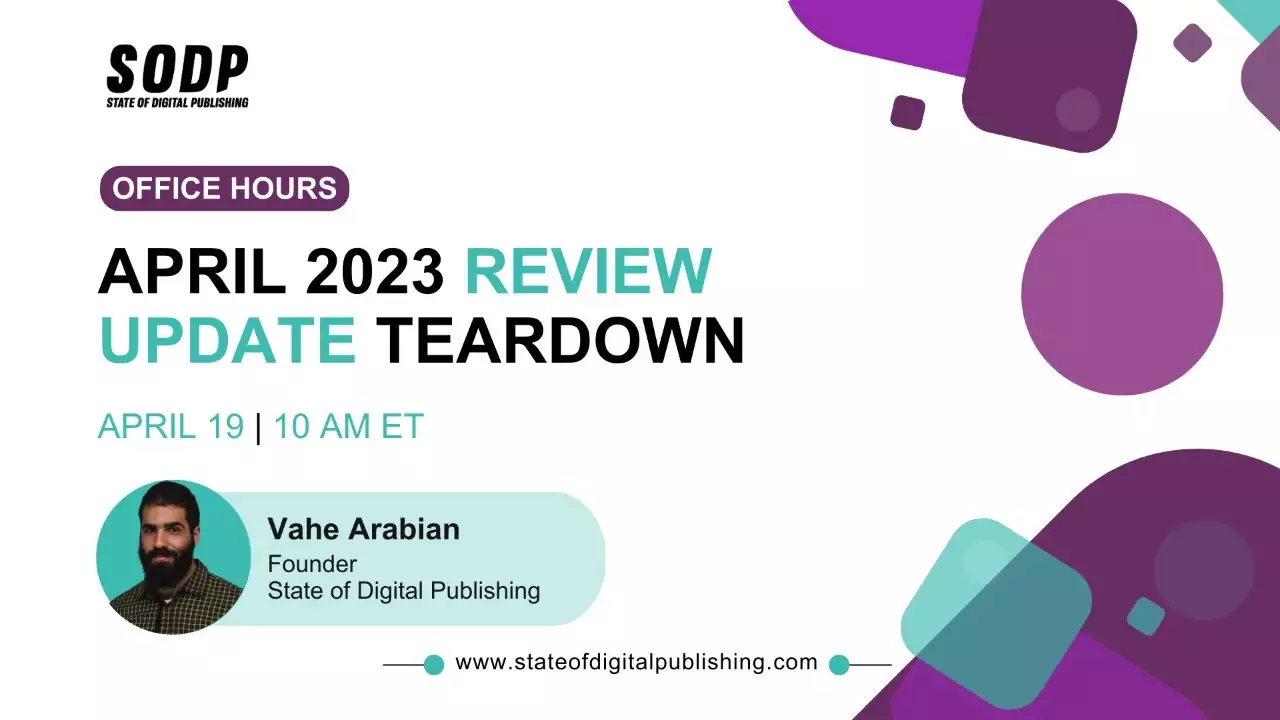Editorial workflows are integral to the publishing process — they allow for an idea to be brought to life and then presented to an audience.
Whether the process is carefully documented or lives in “muscle memory”, every publisher uses one to create and distribute content.
Successful publishers, however, don’t just have a content creation process. They have also documented their processes, thereby making it easier to ensure quality content and transfer the existing knowledge pool to new staff.
While uncertainty can arguably drive the creative process, for digital publishing to be profitable then it needs a good editorial workflow that eliminates uncertainty and reduces waste.
Table of Contents
What Is an Editorial Workflow?
An editorial workflow encompasses the processes that determine how a publication creates, edits, publishes and manages content.
While the term “editorial” may conjure up images of writers, sub-editors and editors working to create content, these workflows can affect so many other team members. These include:
- Content strategists
- SEOs
- Photographers
- Illustrators
- Social media teams
- UX designers
- Production managers
Creating content can require input from these specialists at various stages of its life cycle, such as:
- Ideation
- Research
- Writing
- Editing
- Image creation
- Production
- Publication
- Marketing
Having a streamlined editorial workflow in place is a key step toward helping businesses realize their content strategy goals.
Why Is Documenting Editorial Workflows Important?
Workflows exist in every industry and the publishing industry is no exception. Well-documented and fully implemented procedures help to reduce editorial inefficiencies.
Documenting a workflow is the first step towards understanding whether the systems and processes in place are actually working. This then opens up the possibility of improving the editorial process in search of the following benefits.
- Significantly improve content quality/quantity. Depending on a publisher’s objectives and goals, workflows can be optimized either to publish fewer but more impactful pieces of content or focus on covering lots of topics at the expense of depth of coverage.
- Reduce operational inefficiencies. Working without an established workflow means that content is produced using inherited and poorly understood processes. This produces operational inefficiencies such as missed deadlines, missed sponsorship and advertising opportunities or subpar quality control.
- Foster ownership. Removing uncertainty around task accountability allows teams to take full responsibility for their results and makes setting and achieving KPIs more manageable.
As noted above, whether publishers know it or not, they already have an editorial workflow. While it can be something as basic as researching > writing > publishing, it’s more likely to include editing, graphical design, page layout, SEO and content marketing strategy efforts.
While a workflow is the blueprint that will determine how much a publisher can scale, it’s important to remember that there is no one-size fits all approach.
Every publisher must tailor their workflow to meet their needs and capacity. With that in mind, let’s look at how to document workflows and then improve them.
How to Establish and Optimize Editorial Workflows
The first step to developing an effective editorial workflow lies in documenting how things are currently done.
This will establish a knowledge base that can be developed over time and will more easily facilitate knowledge transfers between existing and new team members.
1. Identify and Document
There are many ways to collect a list of steps and their associated actions. One of the simplest ways is to create a “living” cloud-based document that the whole team can readily access and update.
Focus on more than just content creation and expand the document to include content strategy, publishing, promotion and governance.
Be patient. The documentation process can be a journey of discovery for the entire team and it is one that should be pursued in granular detail. Start with identifying the overarching phases of the editorial workflow and then delve deeper.
Ask questions; the more the better. Questions help clarify the company’s, department’s and individual’s processes, missions and goals. Each question that is asked, answered and documented means one less knowledge gap for the whole team.
When documenting State of Digital Publishing’s (SODP) topic creation phase we realized that the SEO and editorial teams had overlapping responsibilities.
This overlap was leading to delays because it wasn’t always clear who was responsible for certain tasks, such as the creation of writer briefs. We identified which parts of the workflow each department was responsible for, documented each step and created standard operating procedures (SOPs) that the team could follow.
Not only did this allow us to assign tasks with greater clarity, but it also opened the door to automating certain steps and creating training documents for new hires.
2. Ownership
After a process has been documented, the team needs time to fold it into their schedule and then identify gaps in the workflow.
This step empowers each team member to work on identifying the shortfalls in their own capabilities, such as time management.
Have checklists that the editorial team has to follow. If possible, divide each step into checklists so that the process is clear and there’s a proper handoff between colleagues.
As more tasks are identified and then assigned, create detailed timelines for each to identify potential bottlenecks. This is also a great way to review and possibly reset management expectations.
For example, there might be too few team members responsible for editing and publishing videos, limiting video production for social media channels. Management can then address this by either reducing workload requirements or hiring more video editors.
3. Feedback
Give the team time to adopt the documented processes, but then schedule a time to secure feedback.
It’s not enough to understand where the bottlenecks are, it’s important to understand why they’re appearing. Those responsible for the task can provide valuable insight into fundamental problems and guide the development of practical solutions.
For example, the editorial or SEO teams may be sending articles back to writers multiple times, leading to publishing delays. It is important to understand why this is happening.
What was missing from the writer’s first draft? Does the writer know enough about the subject to meet expectations? Were the editorial team’s expectations clearly conveyed? Was the brief detailed enough?
Answering each of these questions may lead to more questions, but following the process to its conclusion will help hone in on the problem. For example, it may reveal weaknesses in the writing team, problems with the assigned briefs or even with how feedback is being communicated — it could even be a combination of all three.
Without asking questions from those carrying out the tasks and having them talk to each other it will be impossible to identify all of the issues affecting the workflow.
4. Optimize
As workflows are documented and adopted, structural problems will slowly begin presenting themselves. This is a good thing. Publishing companies need to find as many “edge cases” as possible before sharing the solutions with the entire team. This will reduce the likelihood of having to create bespoke, siloed solutions in the future.
An organized workflow can be tailored to suit different types of content and media. While a blog post, podcast and short-form video for social media are different media, they all have to go through roughly the same journey from creative to audience.
Adapting a document workflow for one medium to another cuts down on duplicated labor while providing a clear and consistent plan to follow.
At the same time, it is important not to become complacent. Workflows can always be improved and, while it’s important to give the team time to settle into the groove of a new workflow, it’s important to repeat Steps 1-3 at set intervals — think four to six months — in order to introduce iterative improvements and optimize over time.
SODP’s SEO-Focused Editorial Workflow
Each publisher needs to find the editorial workflow that best suits their content, goals and resources.
What we present here is State of Digital Publishing’s (SODP) editorial workflow, which integrates SEO practices as well as a topic cluster strategy.
Step 1: Research
This is the strategy phase, where we research and plan our topic pillar and clusters. It’s here that we look for topics that we want to rank for in search engines.
This stage involves a great deal of keyword research, to balance search volume and keyword difficulty. With this information, we then can map out our content pillar and the different supporting topic clusters.
We use various tools such as Ahrefs, SurferSEO and keyword generators to gather raw data and process it through templates that will show us which content coverage will give us and our clients the best chance of drawing an audience.
Our Tip: For publishers new to the SEO process, this can seem like a daunting, and even esoteric, process. However, it doesn’t have to be.
Start slow and focus on a desired niche. Use Google Search to understand what topics the competition is covering, which of their stories are performing well, which subjects could be covered in more depth and which stories haven’t been covered at all.
This is a relatively old-school way of approaching R&D, it is a low friction way of starting the SEO process. From there add one or two free research tools at most and begin exploring how to maximize their value.
For a more advanced approach to building a pillar and cluster strategy, have a look at our Content Cluster Strategy Toolkit, which breaks down the process into different steps.
Step 2: Editorial Calendar
Once the topic and clusters have been determined, we’ll then fill our editorial calendar so we have a clear idea of our deadlines.
An editorial calendar can be so much more than deadlines, though. Our calendar includes content type, assigned writer and the various stages of review — all of which allows the editorial and SEO teams to understand at a glance each project’s progress.

Our Tip: We recommend keeping the editorial calendar simple at the start. There’s no shame in using a pen and paper if it helps with the early stages of process mapping. This provides a foundation that can be carried into software solutions such as Nifty, Asana, Trello, etc.
While we used almost exclusively Nifty, we opted to integrate Google Sheets into our daily workflows because of its landing page-like functionality. It keeps the team focused on tasks with more immediate deadlines.
There are plenty of tools that can streamline the editorial calendar creation process and choosing the right one simply comes down to the publisher’s specific needs.
In the end, an editorial calendar can show just a project title and a deadline, or it could include features such as status tracking, editorial notes and even draft management.
Step 3: Content Creation
Now that the topics have been selected and deadlines assigned, it’s time to begin creating the content. However, there’s more to this process than simply beginning to write.
For us the process begins with creating a brief. We start with SurferSEO, as it automatically generates certain guidelines — such as keywords, word count and number of images — based on certain criteria that includes our target keyword and an automated analysis of competitor articles.
SurferSEO generates a basic brief and includes options to populate subheadings to flesh it out further. However, we’ve found this approach to have its limitations when developing briefs that our writers can easily implement.
Instead, we prefer a more hands-on approach. We use a selection of our own skeleton templates to quickly build an outline for writers that contains all the points that must be covered as well as links to potential reference material.
Our briefs also contain quality standards, a style guide and any internal links that should be included. This cuts down on writer confusion, and helps them to deliver content with fewer clarification emails and rounds of editing and SEO feedback.
At this point, it’s time to either write the piece in-house or assign a freelance writer. This is also the time to start thinking about custom graphics and licenced images, basically any artwork that will make the article easy to read though and comprehend.
Our Tip: Be as thorough and as detailed as possible during the brief creation phase. Detailed briefs give writers a better chance of “getting it right” first try. It also helps clarify the narrative before assigning work, which should cut down on costly rounds of edits and feedback.
Also, think about images early and use license-free stock images while developing in-house capacity.
Step 4: Copy Review
Content from our partners
Once a piece of work has been created it then needs editing, an SEO review and then a final proof.
Any of these stages can reveal issues that the writer must address. We’ve worked to ensure that our briefs are clear enough that one round of feedback should be enough for the writer to deliver the article we’re looking for.
Beyond the obvious benefits of spending less time going back and forth with writers — a process that can be significantly lengthier when dealing with either freelancers or junior team members — it also highlights potential writer weaknesses. This, in turn, will create an opportunity for training or a rationalization of the writing pool.
For a closer look at how we approach the hiring process, watch our May edition of Office Hours, where we go into more detail about content pipelines.
Our Tip: Build redundancy within a writing pool. Freelancers are a great way to ensure there’s always creative capacity, though this comes with its own set of challenges. If quality is of paramount importance, then be ready to hire slowly and fire quickly.
This means that hiring should be a constant process. While this can be a tedious process it does allow for incremental improvements to the writing pool, with those that fall short on quality gradually edged out in favor of more capable writers.
Step 5. Distribution
With reviews in the rearview mirror, it’s the moment of truth — time to publish. This is also the stage when the marketing team needs to think about promotion strategies that can be used to enhance audience discovery.
Given our B2B focus, it should be of little surprise that we count on SEO practices to help appeal to our somewhat niche audience category. That’s not to say we stop there, however, and also rely on social media to build awareness about our recently published work.
Our Tip: Understand which content fits which marketing channels best. While we rely on SEO, that might not be the best fit for every publisher and it is important for publishers to consider whether their content might perform better in a different channel.
Step 6. Re-optimize
Content, just like an editorial workflow, can’t be created and then neglected. We regularly review story performance to ensure that it is performing. We use Google Search Console (GSC), Ahrefs and SurferSEO to conduct these reviews.
We’ll conduct a search engine results page (SERP) analysis to understand what Google shows users based on their search intent. Then we’ll study our competitors to see how in-depth their topical coverage is and whether they’ve missed any key elements that we can include based on user intent.
These steps help to inform us as to how well older content is ranking. Potential reasons for underperformance include a weak structure, lack of keyword targeting or low topical coverage.
During these reviews we’ll take one of four actions:
- Leave as is
- Adjust and optimize
- Merge and delete
- Archive
Inaccurate or outdated content can damage brand perception.
Our Tip: Don’t fall victim to the “publish and forget” trap. Schedule time to revisit old content for optimisation and performance improvements. Working on improving existing articles and making them more evergreen, or updating and expanding them, can be a quick and easy way to improve performance.
If a publisher doesn’t have the resources to conduct a content audit in-house, then we recommend enlisting the help of a professional SEO service provider. Understanding what is and isn’t working is essential to the development of an effective content strategy.
Final Thoughts
Whether a one-man operation or an organization with dozens of employees, having a documented editorial workflow can help any and all publishing schedules, eliminate inefficiencies and scale operations while avoiding disruptions.
The fact is, every publisher already has an editorial workflow process, even if they don’t know it. By identifying their current editorial process, publishers can either develop a new workflow or optimize the existing one to ensure it allows them to reach their full potential.












